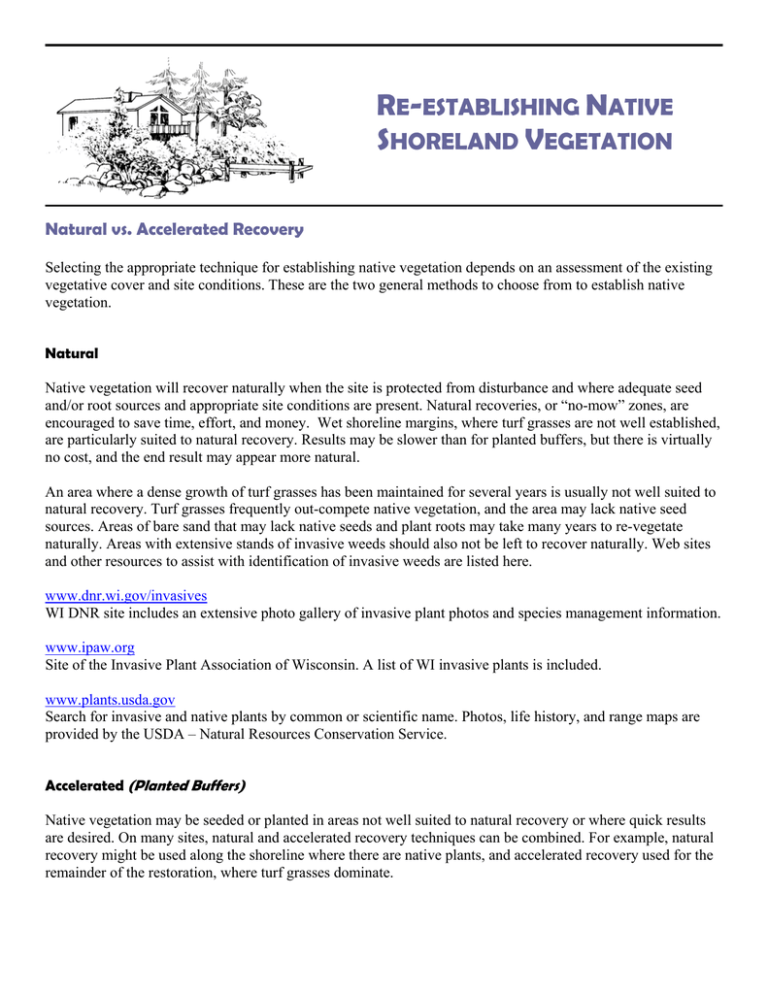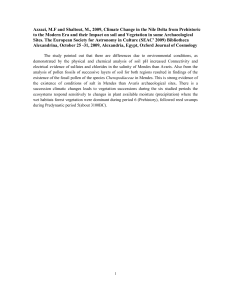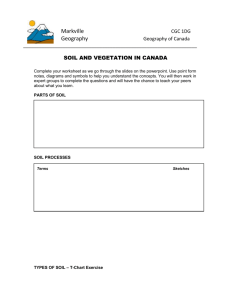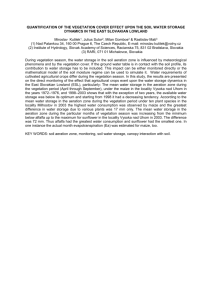R - N
advertisement

RE-ESTABLISHING NATIVE SHORELAND VEGETATION Natural vs. Accelerated Recovery Selecting the appropriate technique for establishing native vegetation depends on an assessment of the existing vegetative cover and site conditions. These are the two general methods to choose from to establish native vegetation. Natural Native vegetation will recover naturally when the site is protected from disturbance and where adequate seed and/or root sources and appropriate site conditions are present. Natural recoveries, or “no-mow” zones, are encouraged to save time, effort, and money. Wet shoreline margins, where turf grasses are not well established, are particularly suited to natural recovery. Results may be slower than for planted buffers, but there is virtually no cost, and the end result may appear more natural. An area where a dense growth of turf grasses has been maintained for several years is usually not well suited to natural recovery. Turf grasses frequently out-compete native vegetation, and the area may lack native seed sources. Areas of bare sand that may lack native seeds and plant roots may take many years to re-vegetate naturally. Areas with extensive stands of invasive weeds should also not be left to recover naturally. Web sites and other resources to assist with identification of invasive weeds are listed here. www.dnr.wi.gov/invasives WI DNR site includes an extensive photo gallery of invasive plant photos and species management information. www.ipaw.org Site of the Invasive Plant Association of Wisconsin. A list of WI invasive plants is included. www.plants.usda.gov Search for invasive and native plants by common or scientific name. Photos, life history, and range maps are provided by the USDA – Natural Resources Conservation Service. Accelerated (Planted Buffers) Native vegetation may be seeded or planted in areas not well suited to natural recovery or where quick results are desired. On many sites, natural and accelerated recovery techniques can be combined. For example, natural recovery might be used along the shoreline where there are native plants, and accelerated recovery used for the remainder of the restoration, where turf grasses dominate. Addressing Concerns You are likely to have a variety of questions and concerns about restoring a shoreline buffer. Some of the more common questions and their answers are listed here. How will the restoration affect my view? Restoration plantings can be arranged to frame rather than block desirable views. Will the mosquitoes increase? Mosquitoes increase with added standing water, not increased vegetation. How soon can I expect results? The time it takes to see results varies with soil moisture, nutrients, and sunlight. Planting seedlings rather than seeding an area generally speeds up results. Seedlings can start to bloom in the second year, sometimes even the first year if planted early enough. Similarly, planting larger trees and shrubs results in a more finished project sooner. Other questions can be addressed by consulting with a professional for your shoreline restoration design. A list of appropriate consultants and landscapers is available from the Lower Long Lake Protection & Rehabilitation District’s website: www.lllprd.com. Runoff Control Runoff should be maintained in sheet flow (not channels) to the greatest extent possible and directed to areas where it can soak into the ground. Pay special attention to how water will run after the buffer is created. The desired end result is for runoff water to filter through rather than run around the buffer zone. A low berm placed above the viewing corridor opening can direct water flow through the buffer. Runoff from impervious surfaces (driveways, roofs, patios, etc.) and rain gutter downspouts should be directed to maximize infiltration. Rain gardens are an option for infiltration. They are sunken areas planted with flowers and grasses designed to soak in runoff water. This practice is explained in the UW–Extension booklet, Rain Gardens: A how-to manual for homeowners. Cost of Buffer Installation Costs for planting a shoreline buffer vary greatly. Establishing no-mow zones to encourage native plant growth in all or part of the buffer greatly reduces costs. Seeding groundcovers is generally cheaper than planting seedlings, but results will take longer and seeds require very frequent watering. Do-it-yourself installation costs have ranged from nothing for establishing no-mow zones and transplanting shrubs to over $1 per square foot. Costs of native plants and planting supplies only can range from $0.50 to $0.80 per square foot. Professional landscapers charge more, but using an experienced contractor may result in a more successful project. Why Choose Native Plants? Native plants have evolved for thousands of years with the local soils, climate, and shoreline environment. They provide the essential elements of food, shelter, and space for wildlife and fish species. Stands of native plants also act as an efficient sponge, soaking up rain and snowmelt runoff and maximizing groundwater recharge. Many have deep root systems that will stabilize soil and prevent erosion. There are many beautiful native plants to choose from to enhance the aesthetic value of your property. Once established, they will require little care. Site Preparation Proper site preparation is one of the most important steps in establishing a native plant landscape. Native plantings can survive on poor, sandy soils and eventually will require little maintenance. However, you might need to lessen the competition on the site by first removing the existing vegetation. Turf grasses can quickly out-compete newly planted native grasses and wildflowers if left in place. Sometimes removing existing vegetation is not necessary, and it is possible to plant among existing scattered native plants and/or poor grass cover or to leave zone of vegetation intact. The moist zone near the water’s edge often consists mostly of native plants because turf grasses are flooded out. Seeds and underground stems may quickly revegetate the area if allowed to grow. Selected native flowers, grasses, and shrubs can usually be planted among existing native vegetation to fill in bare spots or to add color and variety. Stands of invasive plants like reed canary grass or purple loosestrife should be removed from wet areas. Ask for assistance with a site evaluation if you are unsure if removing existing vegetation will be necessary. Removing Existing Vegetation SMOTHERING – USING BLACK PLASTIC Black plastic spread over vegetation eliminates light and creates heat that kills existing plants. This method is suitable for almost any site. In areas with high exposure to wing, extra care must be taken to anchor the plastic in place. Explain the purpose of the plastic to your neighbors; they might wonder! 1. You will need: 3.5 mil or thicker black plastic to cover the area, plus extra to overlap sheets at least 6 inches. 4 inch or long 11 gauge or heavier U-shaped metal staples. (enough to space 1 foot apart where plastic overlaps and at the edges) Heavy objects like logs, cement blocks, boards, or tires to hold the plastic in place. 2. Prepare the site by mowing, weed whacking, or trimming vegetation to be removed, 3. If the soil is dry, water it thoroughly. 4. Lay down the plastic. Get some help and choose a calm day. Overlap the plastic at least 6 inches if using more than one piece. Go around or cut holes for any existing plants you with to preserve. 5. Anchor the plastic firmly in place using long U-shaped staples and heavy objects to be sure it stays there. All seams and edges must be firmly anchored to exclude light. 6. Leave plastic in place 6-8 weeks during spring or summer. Make certain there is no sign of living vegetation before removing it. 7. Remove plastic and plant directly into dead vegetation without tilling. APPLYING HERBICIDE Herbicide is a much faster way to remove vegetation, but it must be used carefully and according to label instructions. 1. A glyphosate herbicide like RoundUp® is recommended. These herbicides only affect plants directly sprayed, and will break down into harmless substances rapidly. Vegetation must be actively growing for this herbicide to be effective. To encourage growth, mow grass and allow it to regrow several inches. 2. When applying an herbicide, shield and spray around existing native plants. Avoid drift of herbicide to water. If herbicide is to be applied in or over the water, an aquatic glyphosate formulation such as Rodeo® must be used and a permit received from WI Department of Natural Resources. 3. Timing of herbicide application is crucial. Do not apply when rain is forecast within the next 24 hours or on a windy day. 4. Wait at least 7-10 days before planting native plants. Be certain that vegetation is dead before planting. If turf is still green or yellow-green, a repeated application is recommended. 5. Leave dead plant material in place. It will serve as mulch for the new plants by holding moisture, anchoring soil, reducing weed growth, and contributing organic matter to the soil. Soil Amendments In most cases amending the soil is not required to plant native plants as long as they are chosen to match the soil, moisture, and light conditions at the site. Adding black dirt or manure can be detrimental to shoreline plantings. These soil amendments may favor weed growth, and the native plants may grow too quickly and be less sturdy. Occasionally, soil amendments are necessary. It is wise to have the soil tested if you have any questions concerning its type, pH, or fertility. Contact the county UW-Extension office for a soil test kit. In highly acidic soils (less than 5.5 pH), adding lime may encourage plant growth. Fertilizers may also be required for soils having low nutrients. Fertilizers may be used where mulches are present because they demand nitrogen as they decompose. Fertilizer should never be broadcast due to the potential for runoff into the lake. Instead, apply a very small amount of organic fertilizer in each planting hole. For a 6-0-6 NPK ratio, use one teaspoon of organic fertilizer per grass or wildflower plant and ¼ cup per shrub or tree. Up to one cup can be added to larger shrub or tree planting holes. An organic rather than a chemical fertilizer will release nutrients more slowly and is less likely to burn plant roots or run off into the lake. Use phosphorus-free or very low phosphorus fertilizer. Phosphorus levels are adequate in most soils, and phosphorus can increase algae growth in the lake. (Phosphorus is the middle number of the three listed on the fertilizer bag.) Preventing Erosion of Exposed Soils Bare soils must be stabilized to avoid serious erosion problems. Bare soils may be present because of erosion from runoff, bank instability, heavy use, or construction activities. Eliminate or minimize the cause of the bare soil and then stabilize the area following the guidelines below. Any bare sand or dirt should be planted with seeds and/or seedlings and mulched. Additional stabilization methods are necessary on sloped areas. All Sites: Seed or plant permanent vegetation and mulch After Sept. 15 Temporary seeding of annual rye Permanent seeding for next growing season Slopes > 12% Companion seeding of oats, annual rye, or Canada wild rye Slopes > 20% Companion seeding of oats, annual rye, or Canada wild rye Mulch, net, and plant SEEDING RATES PER 1,000 SQ. FT. Annual Rye (after August 1): 0.5 – 1 lb. Oats (until August 1): 0.5 – 1 lb. Canada Wild Rye: 1 oz. NETTING INSTRUCTIONS 1. Divert channelized water from above (such as from a rain gutter downspout) to an infiltration area to help minimize erosion so vegetation can be established. 2. Bring in small amounts of topsoil or sand to even the slope where it has eroded. Check with the Chippewa County Zoning Department for potential permits needed before adding fill or topsoil. Filling is regulated in the shoreland area. 3. Seed a temporary cover of oats, annual rye, or Canada wild rye. Complete permanent seeding in this step unless seedlings are to be planted in step 6. 4. Cover with an excelsior (wood fiber) erosion control mat or mulch and jute or plastic netting. For best stabilization, unroll the mat or netting parallel with the slope. Overlap edges 4-6 inches. 5. Stake mat or netting in place using 6 inch or longer 8-guage or heavier wire staples. They should be spaced every 3 feet along the edge and where the net or mat overlaps. 6. Plant seedling plugs of native grasses and flowers through the mulch. Choose plants from the appropriate list based on sunlight and soil moisture. Space seedlings 1 foot apart. Use at least 50 percent native grasses on steep slopes. The deep roots will help to stabilize the slope. 7. You may need to replace mulches, mats, or nets after periods of prolonged rainfall. Replace them as soon as possible to maintain suitable coverage and prevent erosion until permanent vegetation is established. Installation of filter fabric, or silt fences, may be necessary to capture sediment below exposed slopes. Steps for Planting Seedlings 1. Assess existing vegetation. It might be possible to plant among existing native vegetation or into a poorly established lawn. If native vegetation dominates or lawn grasses are poor, skip step 2. 2. Remove non-native competing vegetation such as turf grasses and invasive weeds through smothering or applying herbicide as described in this publication. 3. Plan your planting scheme. Spacing plants 8-12 inches apart is recommended for very sandy soils. Spacing 12-18 inches is adequate for moist soils. You may choose to space further apart in established no-mow areas to which you are adding. 4. Lay mulch down prior to planting. Spread 3 inches of straw, leaves, or pine needles to conserve moisture and reduce weed growth. If using oak leaves, chop them up by running over them with a mower or through a leaf shredder. Avoid using field hay because it generally contains weed seeds. Two inches of wood chips can be used in areas with moist, rich soils. Wood chips tend to shed moisture, retard spreading of plants, and use nitrogen as they decay. 5. Be ready to water. Watering plant seedlings is critical to their success. Be ready with hoses and sprinklers before you begin to plant. 6. Dig holes for plants. This will speed up planting. A bulb planter or 2” bulb auger drill bit attached to an electric drill work well for planting. Make sure the holes for the plants penetrate the dead grass. 7. Fertilize. A small amount of organic, phosphorus-free or very low phosphorus fertilizer is recommended for sites with low fertility. The second number on the fertilizer label indicates the percentage of phosphorus. For a 6-0-6 NPK ratio, place a teaspoon in each plant hole. Excess fertilizer will encourage weed growth. 8. Place live plants in the ground soon after they are brought to the site. If you must keep them a few days before planting, keep them in an area with partial sun such as on the east side of a building or under a deciduous tree. Do not leave them in a dark area for long periods; this will weaken plants. Water to keep packs moist once or twice a day. 9. Plant in the cool hours of the day. Plants will have a greater survival rate if planted on a cool day or during the morning or evening hours. To plant, separate the mulch, dig a hole, sprinkle organic fertilizer (if needed), place the plant plug in the hole, press the soil gently around the plug, and replace the mulch, being careful to keep the mulch ½ inch from plant stems. 10. Water. Don’t forget this important step to give your plants a good start. Water immediately after planting. Plan to water daily for the first few weeks or until plants are well established. If plants wilt or droop, a repeated watering during the day may be necessary. Once plants are established, water only if prolonged dry periods occur. Plant at least 30 percent grasses to stabilize the soil and provide and attractive backdrop for flowers. Seedlings can be planted from May 15 until September 15. Shrub and Tree Planting 1. Keep bare-root stock moist and cool before planting. Dormant bare-root shrubs can be ordered in the fall or winter for delivery in the spring. Plant bare-root stock as soon as it arrives. If you must wait to plant, store bare-root stock close to 34 degrees Fahrenheit to avoid breaking dormancy. Keep roots moist be periodically sprinkling with water. Do not soak roots in water because this will deprive them of oxygen. 2. Dig the hole deeply enough so that the roots won’t curl or bunch up. The trees and shrubs should be planted about one-half inch deeper than they were in the nursery. Paler colored bark and a slight swelling on the stem mark the old soil line. 3. Pack soil firmly around the roots. Air pockets left around the roots will dry them out. Pack soil firmly but gently around the roots with your foot. 4. Water regularly to keep soil moist but not saturated. 5. Mulch a two-foot diameter circle around each plant 2 to 3 inches deep with wood chips, straw, or leaves. This will reduce competition with other plants. Keep this area free of other growth by weed-whacking or hand-pulling weeds for the first couple of years. Potted shrubs may be planted any time the soil is not frozen. Transplanting Trees and Shrubs It is best to transplant when trees and shrubs are dormant in the early spring or late fall. It might help to identify and label trees and shrubs when leaves are on the plants. Dig up as much of the root as possible. Replace the duff layer of leaves and stems to reduce erosion at the site. Only dig up trees and shrubs if they are part of a large stand or if the seedlings are numerous. It is important to know that digging plants from public lands is illegal. You may dig plants from private land if you have permission from the property owner, or the land is your own. Steps for Planting Seeds 1. Remove non-native competing vegetation by smothering or applying herbicide as describe in the site preparation section. Rake or till only enough to expose soil for planting seed – no more than 1-2 inches deep. 2. Select seed. Use three to eight ounces of seed for every 1,000 square feet. Greater amounts of seed will result in denser growth and better chances for success. Include one ounce of Canada wild rye per 1,000 square feet as a companion seeding or cover crop if desired. This cover crop will germinate readily to indicate areas where seeding is successful and help to hold the soil in place. Canada wild rye is a shortlived native perennial grass. 3. Mix seeds with slightly moist sand. Fill an ice cream pail or similar one gallon bucket 2/3 full with moist, but not wet, sand. Add up to 4 ounces of seed and mix well. The seeds will adhere to the sand so they can be spread more evenly. 4. Broadcast the seed/sand mixture. Use half of the seed/sand mixture to cove the entire area. Sow the remaining half by walking perpendicular to the line of the first pass to assure good seed distribution throughout the area you wish to plant. The sand will make it easier to see places that have not been seeded. 5. Press seed in by tamping down the soil with a rake or lightly raking the seeds in. You may also roll the site with a water-filled roller to insure good soil/seed contact. Never roll with soil is wet, this will compact the soil, decrease oxygen levels in the soil, and reduce seed germination. 6. Mulch lightly with ½ inch of weed-free straw. Do not use field hay, as it contains numerous weed seeds. Soil must be visible between the straw stems. Otherwise, the mulch is too thick to allow seedlings to grow. 7. On steep slopes, hold the mulch in place by staking down a jute or plastic net. An excelsior erosion control mat up to ½ inch thick may be used as an alternative to mulching and netting. 8. Water immediately following seeding. Don’t forget this important step to give your plants a good start! Watering seeds and small seedlings after sprouting is critical for sandy soils. Plan to water daily, preferably in the morning, for the first few weeks or until plants are well established. Check to see that soil is moist beneath the mulch. Very sandy sites may require watering more than once daily for the first few weeks. Once plants are established, water only if prolonged dry periods occur. Seed groundcovers from May 20 through August 10. The best time to plant is in June. 9/07 LLLPRD/The Green Frog Co. Adapted with permission from Shoreline Buffer Restoration: A Guide for Landowners; Written by Harmony Environmental, for Burnett County Land & Water Conservation Department, 2006; Funded by WI Department of Natural Resources





